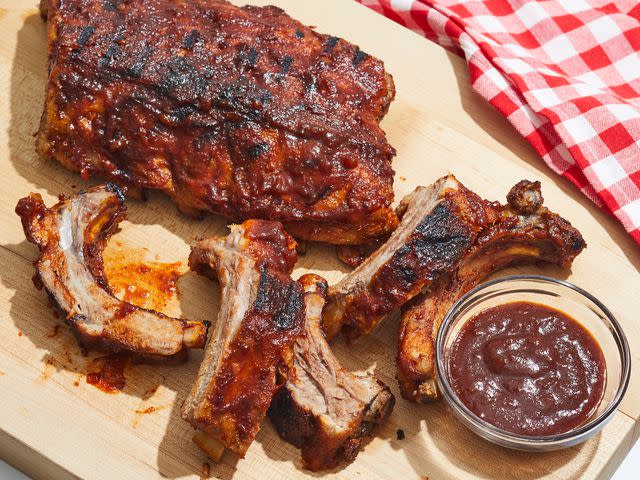Spare Ribs vs. Baby Back Ribs: What's the Difference and Which Is Better?
Let’s find the best ribs for your barbecue.
Judging solely by the names — spare and baby back — you would naturally assume one rack of ribs is smaller than the other, and that assumption would be correct. (Though if you assume one of them is extra, you'd swing and miss.) That said, size isn't the only detail that sets these two cuts of pork apart, so let's dive in.

Spare Ribs
Spare ribs are anything but spare, making up the bulk of the rib section along the side and into the belly of the animal. Being large and meaty, with defined bones and a copious amount of delightful fat, spare ribs are widely considered to be the most flavorsome and the go-to choice for barbecues and get-togethers everywhere.
Spares are located beneath the baby backs and, once cut, show a noticeable ridge along one side with marrow poking out, marking where they used to meet up with them. The opposite side may have some gristle and cartilage, marking its connection with the chest.
Related: 13 Delicious Side Dishes for Ribs
The USDA requires a slab of spare ribs to be at least 11 bones. These bones have very little meat on top, but a lot in between them, known as flap meat, which was once the diaphragm. Of course, all you really need to know is that those meaty sections between bones are the hearty, satisfying bites you look forward to when holding the end of a rib in each hand.
These slabs of ribs are often trimmed down, removing any trace of breastbone and overly chewy cartilage, creating a pretty perfect rectangle of ribs. These are called St. Louis-style. Their flatness makes them much easier to brown when cooking, while their size requires a longer cooking time than their “baby” relatives.
Related: 5 Best Ways to Make Oven-Baked Ribs
Spare ribs weigh about 2 ½ to 3 pounds per slab, the marbled fat and extra bones and tissue measuring up to an extremely flavorful, rich and luscious mouthful that's easier on your wallet, because it isn't all meat. Their size may be daunting, but in the end, each slab is mostly bone, feeding just two people well or three to four lightly.
Must-Try Spare Rib Recipes:
Baby Back Ribs
I'll get this out of the way up front — baby back ribs do not come from baby pigs. Instead, their name references their size, being smaller than spare ribs. They also have a steeper curve and are leaner and more tender. These ribs come from the upper rib cage, attached to the spare ribs on one side and the backbone (or spine) on the other, making up the "back" portion of their moniker. The entire slab of 11 to 13 bones weighs about 2 pounds and their petite stature allows them to cook faster.
Related: Our 11 Best Smoked Barbeque Ribs Will Have You Eating With Your Fingers
These ribs sit just under the loin muscle and while the loin used to be fully trimmed away, baby back ribs have become so popular (thanks, Chili's!), butchers have been known to leave some of that luscious loin meat on the top. This joins their rise in favor to further contribute to their price tag.
Even less bang for your buck, one slab on the heavier side will only feed one to two people, depending on their appetite.
Must-Try Baby Back Rib Recipes:
Swapping Sizes
There's really no right or wrong way to rib — any pork rib recipe can be swapped out with either type — just be mindful of your cook time in consideration of size. The larger spare ribs will need a longer cook time than their smaller counterparts. Spare ribs also cook best with low and slow heat, whereas you'll have to keep checking on the little guys to keep them from drying out.
Which Ribs Should You Buy?
When it comes to one versus the other, neither definitively reigns supreme. What you choose to slather your BBQ sauce on or tenderly rub down with spices is purely a matter of preference and price tag.
But no matter which slab you're slinging, there are a few things you'll want to keep your eyes peeled for while shopping. Visually, you'll want to see defined fat marbled throughout, meat that's a beautiful pink/red color (no discolored patches or dried out ends), and a thickness that's as even as possible for more consistent cooking.
Related: 17 of Summer's Best Barbeque Ribs
Finally, and perhaps most importantly, check that the meat covers the bones nicely. If the bones are overly exposed (sometimes called a "shiner" rack), you risk them falling out while cooking, about the largest disappointment you can have when getting ready to tie on that bib and dig in.
Read the original article on All Recipes.

